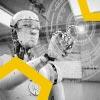ISRO’s AI Robot Vyommitra Boards Gaganyaan Crew Capsule: Key Roles in Space

Podcast
News Synopsis
The Indian Space Research Organisation (ISRO) is set to make history with the uncrewed test flight of its Gaganyaan spacecraft in December 2025. Instead of carrying astronauts, the mission will feature Vyommitra, an AI-powered half-humanoid robot designed to test spacecraft systems and replicate human functions in space.
First Uncrewed Gaganyaan Test Flight
The Gaganyaan G-1 mission, scheduled for December 2025, will mark ISRO’s first trial of its crew capsule without human astronauts. ISRO chief V Narayanan explained that Vyommitra will serve as a proxy for human crew members, helping to evaluate critical spacecraft operations in orbit.
Following this initial test, ISRO plans two additional uncrewed flights next year to ensure the safety and reliability of the spacecraft before sending humans to space.
What is Vyommitra?
Vyommitra’s name originates from Sanskrit: ‘Vyoma’ meaning space and ‘Mitra’ meaning friend. Developed by ISRO’s Inertial Systems Unit (IISU), Vyommitra is designed as a half-humanoid robot to act as a human substitute during test flights.
The robot features a head, torso, and arms, but no legs, which reduces weight and makes it suitable for microgravity conditions in orbit. Its skull measures 200 mm by 200 mm and weighs just 800 grams, crafted from heat-resistant aluminium alloy (AlSi10Mg).
Vyommitra’s Role in the Gaganyaan Mission
Vyommitra is built to perform tasks typically handled by human astronauts, making it a crucial part of the Gaganyaan test flight. Its functions include:
-
Monitoring spacecraft systems step by step
-
Interacting with the Life Support System to ensure proper functioning
-
Recording environmental parameters like air pressure and temperature
-
Collecting mission-critical data via specialized sensors
Equipped with AI technology, Vyommitra can read displays, press switches and buttons, operate key systems, and respond intelligently during the mission. It is also capable of communicating in Hindi and English, providing real-time feedback to mission control.
Technical Specifications and Design
Vyommitra is engineered to withstand the extreme conditions of space. Key features include:
-
Lightweight design optimized for orbital microgravity
-
Heat-resistant construction to handle high temperatures during re-entry
-
Compact torso and arms for manipulation of controls
-
Smart AI algorithms to simulate human decision-making in flight
This combination of mechanical design and AI intelligence allows Vyommitra to act as a reliable human surrogate during the first test flight, ensuring that Gaganyaan’s systems are thoroughly evaluated.
Future Plans for Human Spaceflight
ISRO is aiming to launch its first human spaceflight by the first quarter of 2027. The crew for the Gaganyaan mission has already been selected and trained, with Vyommitra playing a key role in preparing the spacecraft for human astronauts.
The insights gathered from Vyommitra’s mission will be critical for:
-
Safety assessments for future crewed missions
-
Fine-tuning life support and spacecraft systems
-
Validating emergency protocols and operational procedures
By integrating AI-powered robots like Vyommitra, ISRO ensures that its human spaceflight program is safer, more efficient, and better prepared for the challenges of orbital missions.
Conclusion
Vyommitra represents a major technological milestone for ISRO, combining advanced AI and humanoid robotics to test spacecraft systems ahead of India’s first human spaceflight. The Gaganyaan G-1 mission in December 2025 will not only demonstrate the capabilities of India’s AI robotics but also pave the way for sending the first Indian astronauts safely into space.





